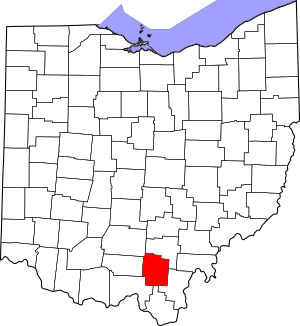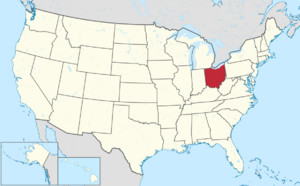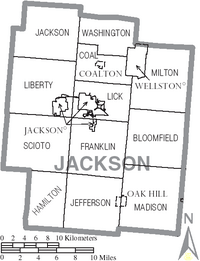Jackson County, Ohio facts for kids
Quick facts for kids
Jackson County
|
|||
|---|---|---|---|

Jackson County Courthouse
|
|||
|
|||

Location within the U.S. state of Ohio
|
|||
 Ohio's location within the U.S. |
|||
| Country | |||
| State | |||
| Founded | March 1, 1816 | ||
| Named for | Andrew Jackson | ||
| Seat | Jackson | ||
| Largest city | Jackson | ||
| Area | |||
| • Total | 422 sq mi (1,090 km2) | ||
| • Land | 420 sq mi (1,100 km2) | ||
| • Water | 1.2 sq mi (3 km2) 0.3%% | ||
| Population
(2020)
|
|||
| • Total | 32,653 |
||
| • Density | 77/sq mi (30/km2) | ||
| Time zone | UTC−5 (Eastern) | ||
| • Summer (DST) | UTC−4 (EDT) | ||
| Congressional district | 2nd | ||
Jackson County is a county located in the U.S. state of Ohio. As of the 2020 census, the population was 32,653. Its county seat is Jackson. The county is named for Andrew Jackson, a hero of the War of 1812 who was subsequently elected President of the United States. It is known as "The Little Wales of Ohio." Jackson County comprises the Jackson, OH Micropolitan Statistical Area.
Contents
History
Jackson County is north of the Ohio River in eastern Ohio, an area that was long occupied by various tribes of Native Americans. Evidence of this era in the Ohio Valley is found in the area's large burial and ceremonial mounds and petroglyphs including the Leo Petroglyph.
Tribes that inhabited the area in the Colonial period included with Mingo, Lenape, and Shawnee. Westward expansion by American pioneers displaced the Indigenous People who were killed in wars or relocated to the Great Plains and placed on reservations following the passage of the Indian Removal Act. The pioneer settlers cleared the land for farming and developed industries around which towns and cities grew.
Iron ore was discovered in southern Ohio in the mid-19th century. The combination of deposits of ore and vast stands of old-growth forests made the Hanging Rock Iron Region ideally suited for the iron industry. The Jefferson Iron Furnace was constructed in 1854. It met the growing demand for iron in the developing United States of America. The importance of the furnaces in the Hanging Rock region grew tremendously during the American Civil War. Iron produced in Jackson County was sold to manufacturers under the trademark, "Anchor". This iron was used to build the USS Monitor, an ironclad warship made famous by its contest against the CSS Virginia, a Confederate ironclad sometimes known as the Merrimack, at the Battle of Hampton Roads.
The era of iron production in Jackson County began to wane in the years following the Civil War. Demand for iron outstripped the resources in the Hanging Rock Iron Region. Ore deposits had been cleared and what remained was minimal and difficult to extract. Also much of the forested land had been cleared to provide charcoal to fire the furnaces. A combination of a lack of ore and charcoal helped bring about the end of the iron era. Remnants of the Jefferson Iron Furnaces are found in Jackson Lake State Park.
Other industries that were in the area included coal mining and salt mining. Over a million tons of coal were mined in 1888. Jackson County was the second leading coal producing county in the state during the coal mining era. Salt mines along Salt Creek were set aside "by Congress for the use of the state to secure the salt." Indian tribes also used the area and came from great distances to gather salt.
Geography
According to the U.S. Census Bureau, the county has a total area of 422 square miles (1,090 km2), of which 420 square miles (1,100 km2) is land and 1.2 square miles (3.1 km2) (0.3%) is water.
Adjacent counties
- Vinton County (north)
- Gallia County (east)
- Lawrence County (south)
- Scioto County (southwest)
- Pike County (west)
- Ross County (northwest)
National protected areas
- Wayne National Forest (part)
Demographics
| Historical population | |||
|---|---|---|---|
| Census | Pop. | %± | |
| 1820 | 3,746 | — | |
| 1830 | 5,941 | 58.6% | |
| 1840 | 9,744 | 64.0% | |
| 1850 | 12,719 | 30.5% | |
| 1860 | 17,941 | 41.1% | |
| 1870 | 21,759 | 21.3% | |
| 1880 | 23,686 | 8.9% | |
| 1890 | 28,408 | 19.9% | |
| 1900 | 34,248 | 20.6% | |
| 1910 | 30,791 | −10.1% | |
| 1920 | 27,342 | −11.2% | |
| 1930 | 25,040 | −8.4% | |
| 1940 | 27,004 | 7.8% | |
| 1950 | 27,767 | 2.8% | |
| 1960 | 29,372 | 5.8% | |
| 1970 | 27,174 | −7.5% | |
| 1980 | 30,592 | 12.6% | |
| 1990 | 30,230 | −1.2% | |
| 2000 | 32,641 | 8.0% | |
| 2010 | 33,225 | 1.8% | |
| 2020 | 32,653 | −1.7% | |
| U.S. Decennial Census 1790-1960 1900-1990 1990-2000 2020 |
|||
2010 census
As of the 2010 United States Census, there were 33,225 people, 13,010 households, and 9,028 families living in the county. The population density was 79.0 inhabitants per square mile (30.5/km2). There were 14,587 housing units at an average density of 34.7 units per square mile (13.4 units/km2). The racial makeup of the county was 97.1% white, 0.6% black or African American, 0.4% American Indian, 0.3% Asian, 0.2% from other races, and 1.4% from two or more races. Those of Hispanic or Latino origin made up 0.8% of the population. In terms of ancestry, 16.1% were German, 12.3% were American, 11.6% were Irish, 10.6% were English and 4.4% were Welsh.
Of the 13,010 households, 33.9% had children under the age of 18 living with them, 50.9% were married couples living together, 12.7% had a female householder with no husband present, 30.6% were non-families, and 25.9% of all households were made up of individuals. The average household size was 2.53 and the average family size was 3.01. The median age was 39.0 years.
The median income for a household in the county was $34,044 and the median income for a family was $42,560. Males had a median income of $36,910 versus $28,618 for females. The per capita income for the county was $18,775. About 18.1% of families and 23.3% of the population were below the poverty line, including 36.5% of those under age 18 and 11.5% of those age 65 or over.
Communities
Cities
Villages
Townships
- Bloomfield
- Coal
- Franklin
- Hamilton
- Jackson
- Jefferson
- Liberty
- Lick
- Madison
- Milton
- Scioto
- Washington
Unincorporated communities
- Altoona
- Banner
- Big Rock
- Blackfork Junction
- Brocks Corner
- Buckeye
- Buffalo
- Byer
- Camba
- Chapman
- Clay
- Comet
- Davisville
- Englishville
- Four Mile
- Garfield
- Glade
- Glen Nell
- Glen Roy
- Goldsboro
- Horeb
- Ironton Junction
- Jackson Heights
- Jonestown
- Keystone
- Kitchen
- Leo
- Lesmil
- Limerick
- Mabee Corner
- Monroe
- Mulga
- Oakland
- Orpheus
- Pattonsville
- Petersburg
- Petrea
- Pyro
- Ratchford
- Rempel
- Roads
- Rocky Hill
- Savageville
- Tom Corwin
- Wainwright
- Winchester
- Vega
See also
 In Spanish: Condado de Jackson (Ohio) para niños
In Spanish: Condado de Jackson (Ohio) para niños




